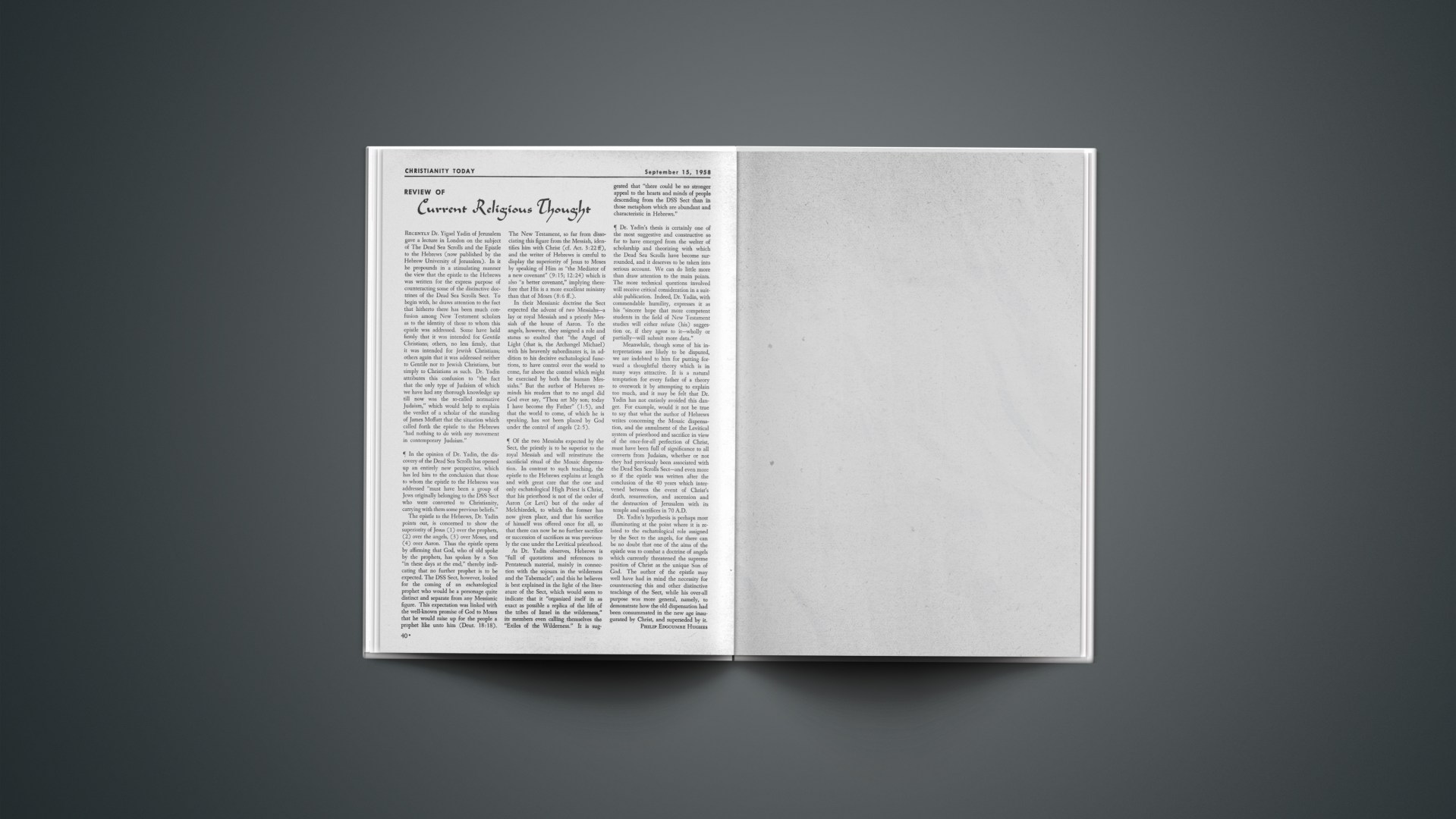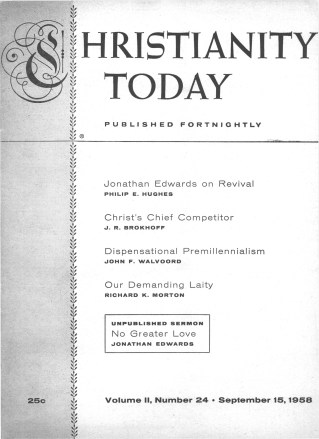Recently Dr. Yigael Yadin of Jerusalem gave a lecture in London on the subject of The Dead Sea Scrolls and the Epistle to the Hebrews (now published by the Hebrew University of Jerusalem). In it he propounds in a stimulating manner the view that the epistle to the Hebrews was written for the express purpose of counteracting some of the distinctive doctrines of the Dead Sea Scrolls Sect. To begin with, he draws attention to the fact that hitherto there has been much confusion among New Testament scholars as to the identity of those to whom this epistle was addressed. Some have held firmly that it was intended for Gentile Christians; others, no less firmly, that it was intended for Jewish Christians; others again that it was addressed neither to Gentile nor to Jewish Christians, but simply to Christians as such. Dr. Yadin attributes this confusion to “the fact that the only type of Judaism of which we have had any thorough knowledge up till now was the so-called normative Judaism,” which would help to explain the verdict of a scholar of the standing of James Moffatt that the situation which called forth the epistle to the Hebrews “had nothing to do with any movement in contemporary Judaism.”
In the opinion of Dr. Yadin, the discovery of the Dead Sea Scrolls has opened up an entirely new perspective, which has led him to the conclusion that those to whom the epistle to the Hebrews was addressed “must have been a group of Jews originally belonging to the DSS Sect who were converted to Christianity, carrying with them some previous beliefs.” The epistle to the Hebrews, Dr. Yadin points out, is concerned to show the superiority of Jesus (1) over the prophets, (2) over the angels, (3) over Moses, and (4) over Aaron. Thus the epistle opens by affirming that God, who of old spoke by the prophets, has spoken by a Son “in these days at the end,” thereby indicating that no further prophet is to be expected. The DSS Sect, however, looked for the coming of an eschatological prophet who would be a personage quite distinct and separate from any Messianic figure. This expectation was linked with the well-known promise of God to Moses that he would raise up for the people a prophet like unto him (Deut. 18:18).
The New Testament, so far from dissociating this figure from the Messiah, identifies him with Christ (cf. Act. 3:22 ff), and the writer of Hebrews is careful to display the superiority of Jesus to Moses by speaking of Him as “the Mediator of a new covenant” (9:15; 12:24) which is also “a better covenant,” implying therefore that His is a more excellent ministry than that of Moses (8:6 ff.).
In their Messianic doctrine the Sect expected the advent of two Messiahs—a lay or royal Messiah and a priestly Messiah of the house of Aaron. To the angels, however, they assigned a role and status so exalted that “the Angel of Light (that is, the Archangel Michael) with his heavenly subordinates is, in addition to his decisive eschatological functions, to have control over the world to come, far above the control which might be exercised by both the human Messiahs.” But the author of Hebrews reminds his readers that to no angel did God ever say, “Thou art My son; today I have become thy Father” (1:5), and that the world to come, of which he is speaking, has not been placed by God under the control of angels (2:5).
Of the two Messiahs expected by the Sect, the priestly is to be superior to the royal Messiah and will reinstitute the sacrificial ritual of the Mosaic dispensation. In contrast to such teaching, the epistle to the Hebrews explains at length and with great care that the one and only eschatological High Priest is Christ, that his priesthood is not of the order of Aaron (or Levi) but of the order of Melchizedek, to which the former has now given place, and that his sacrifice of himself was offered once for all, so that there can now be no further sacrifice or succession of sacrifices as was previously the case under the Levitical priesthood.
As Dr. Yadin observes, Hebrews is “full of quotations and references to Pentateuch material, mainly in connection with the sojourn in the wilderness and the Tabernacle”; and this he believes is best explained in the light of the literature of the Sect, which would seem to indicate that it “organized itself in as exact as possible a replica of the life of the tribes of Israel in the wilderness,” its members even calling themselves the “Exiles of the Wilderness.” It is suggested that “there could be no stronger appeal to the hearts and minds of people descending from the DSS Sect than in those metaphors which are abundant and characteristic in Hebrews.”
Dr. Yadin’s thesis is certainly one of the most suggestive and constructive so far to have emerged from the welter of scholarship and theorizing with which the Dead Sea Scrolls have become surrounded, and it deserves to be taken into serious account. We can do little more than draw attention to the main points. The more technical questions involved will receive critical consideration in a suitable publication. Indeed, Dr. Yadin, with commendable humility, expresses it as his “sincere hope that more competent students in the field of New Testament studies will either refute (his) suggestion or, if they agree to it—wholly or partially—will submit more data.”
Meanwhile, though some of his interpretations are likely to be disputed, we are indebted to him for putting forward a thoughtful theory which is in many ways attractive. It is a natural temptation for every father of a theory to overwork it by attempting to explain too much, and it may be felt that Dr. Yadin has not entirely avoided this danger. For example, would it not be true to say that what the author of Hebrews writes concerning the Mosaic dispensation, and the annulment of the Levitical system of priesthood and sacrifice in view of the once-for-all perfection of Christ, must have been full of significance to all converts from Judaism, whether or not they had previously been associated with the Dead Sea Scrolls Sect—and even more so if the epistle was written after the conclusion of the 40 years which intervened between the event of Christ’s death, resurrection, and ascension and the destruction of Jerusalem with its temple and sacrifices in 70 A.D.
Dr. Yadin’s hypothesis is perhaps most illuminating at the point where it is related to the eschatological role assigned by the Sect to the angels, for there can be no doubt that one of the aims of the epistle was to combat a doctrine of angels which currently threatened the supreme position of Christ as the unique Son of God. The author of the epistle may well have had in mind the necessity for counteracting this and other distinctive teachings of the Sect, while his over-all purpose was more general, namely, to demonstrate how the old dispensation had been consummated in the new age inaugurated by Christ, and superseded by it.










